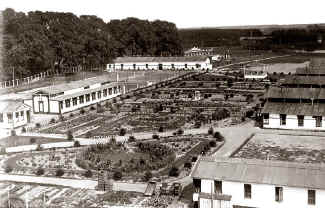|
to
English Camp page
next page
|
British complain of poor food
The English Camp at Groningen 1914 – 1918 (part 4)
This is the fourth part of a series of 13 articles about the history of the English Camp at Groningen, where 1,500 British service personnel were interned during the Great War of 1914-1918.
 |
An overview of the English Camp. To the right of the picture, from bottom to top:
sickbay, with the 3 residential huts behind. To the left of the picture, from bottom to top: office with
library, sports hall and the English admin block.
The sports area is behind the music dome. |
On 16th January 1915 the British sailors were moved from the overpopulated Rabenhaupt Barracks to a new encampment on the drill area of the camp. This was situated behind the former prison, nowadays the Van Mesdag Clinic. Access to the camp was between the Sterrebos woods and the northern perimeter wall. This camp was soon named the English Camp in the city of Groningen; the
British themselves called it Timbertown.
The three battalions Hawke, Benbow and Collingwood were each allocated their own barrack of 240 ft long and 60 ft wide. Each hut could house 500 men. The internees slept in wooden cribs that had been hammered into the low side wings in the manner of bunk beds. The high central area of the hut was used as living area, where benches and tables stood. Each living hut had a ‘dry canteen’ where the internees could purchase drinks and sweets. On either end of the hut, there were rooms for NCOs, in order that they could directly supervise their men.
Each living hut was heated by four large stoves, which were insufficient to cope with extreme cold. John Bentham (see part 3) complains in his diary of warping planks, and snow blowing in through the gaps. It was very close in the huts during the summer months, leading internees to sleep outside. There was one small hut with washing basins and eighteen (cold water) taps. That was apparently deemed sufficient for 1,500 men. A large drying shed was available for drying laundry. On the Helperdiepje [a watercourse] of the camp, latrines and urinals were available. These probably did not drain into the Helperdiepje but the barrels would have been collected once or twice a week. The municipal “Gathering place for faeces” was situated at the end of the Verlengde Lodewijkstraat and could even be reached by water from the English Camp via the Helperdiepje.
The Camp was a separate village with its own facilities. It had its own: recreational hall, doubling as church hall; administrative office, post office with library, sports hall, sick bay and various storage sites. There were guardrooms for Dutch and British guards. The camp was surrounded by a double barbed wire fence, which was lit up at night.
It quickly became clear that the British found the Dutch Government Issue food to be too fatty and lacking in variety. After a number of official pleas from the Britons, the
British were allowed to cook their own food, as long as the allocated budget was not exceeded. The menu consisted of:
- Breakfast: oatmeal porridge with syrup, bread with butter, coffee with milk and sugar
- Hot lunch: fried meat (alternating with venison and fish), potatoes, vegetables
- Supper: bread with cheese or jam and tea with milk and sugar.
Towards the end of the war large shortages of food arose in the Netherlands that resulted from a stagnating import. This was caused by the unlimited submarine war at sea and the export of large amounts of food to Germany. For the
British internees the dearth of food meant that their bread ration (like for their Dutch counterparts) was reduced from 600 to 200 grams per day, as of 1st April 1918. The rations of meat were also reduced. As a protest, some of the internees refused to take part in the compulsory daily marches, stating that they were too weak for that. The Dutch commandant Termaat immediately withdrew afternoon leave, because they would also not have sufficient energy to go out. That helped immediately.
The British complained about the poor food situation in their letters home. One of the letters was published in the 'Morning Post'. An accompanying editorial spoke of the ‘slow death by starvation’ that the
British were suffering in Groningen. Questions were asked in the British House of Commons. Queen Wilhelmina of Holland also asked her Minister of War whether the provision of food for the internees really was adequate. The minister advised the Queen that an investigation had revealed that there was no reason for complaint, as the internees received the same quantity of food as the civilian population and '...the quality is as good as can be expected under the
circumstances…’
Next: Boredom the biggest enemy of interned Britons
  to
English Camp page to
English Camp page
|
|